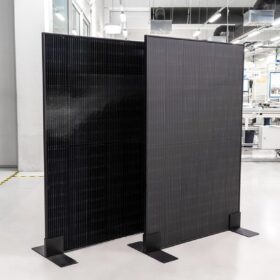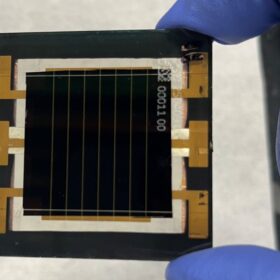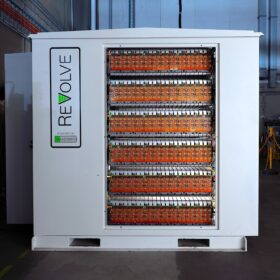PVFarm enhances tracker, terrain tools for large-scale PV planning
Software company PVFarm has improved its single-axis tracker and fixed tilt configurators for planning large-scale projects, adding customisation features and additional support for terrain-conforming designs.
Solar tracker manufacturer offers new terrain-following solution
Spain-based manufacturer PV Hardware has released a terrain-conforming tracker support, enabling up to 2° of variation between posts and enables solar installations on difficult sites without increasing environmental impact or construction costs.
Sinovoltaics releases latest PV inverter manufacturer ranking
The quality assurance firm updated its inverter manufacturer financial stability ranking with APSystems (Yuneng Technology), Sinexcel, and Eaton in the top three spots.
Solitek launches anti-glare black bifacial solar modules
Solitek has launched full-black 425 W bifacial solar modules with matte, satin-textured glass for glare-sensitive sites such as airports, road barriers, and buildings.
Using photoluminescence, implied open-circuit voltage imaging for perovskite solar cell field testing
To evaluate the outdoor performance and stability of perovskite solar cells using contactless and noninvasive methods, an Australian and Chinese research team found a way to use photoluminescence imaging as well as demonstrating a proof of concept for implied open-circuit voltage imaging. Their research relied on cost-effective equipment that operates under direct sunlight.
Upcycling solar glass waste to use in solid-state lithium batteries
Researchers in Singapore have milled solar panel glass waste for use in cathodes in solid-state lithium metal batteries. When used as a functional filler in solid polymer electrolyte (SPE) material, the resulting battery performance was maintained over 80 charge cycles with an 8.3 % improvement over the reference device.
NREL, CubicPV achieve 24% efficiency for perovskite mini solar module
A United States-based collaboration between the National Renewable Energy Laboratory and CubicPV has yielded a perovskite minimodule with certified efficiency of 24.0%. The two noted that it is the first time a U.S. effort has set a record in the perovskite mini module category.
Perovskite solar cell efficiency improves with micro-concentrators
In a novel combination of micro-concentrators and picosecond laser processing, Italian researchers are tackling two metal halide perovskite solar PV challenges to reduce the use of lead and extend stability of the power conversion efficiency.
Sinovoltaics tracks 86.5 GW of module output capacity for Southeast Asia
PV module manufacturing capacity in Southeast Asia has reached 86.5 GW across 61 active sites, according to Hong Kong-based quality assurance firm Sinovoltaics. The figures come from the company’s latest “Southeast Asia Solar Supply Chain Map” report.
Glass-free, coloured PV modules for building rooftop retrofits, facades
Researchers from Swiss and Austrian institutions have demonstrated a novel design for a glass-free, structurally robust silicon PV module. With a weight below 6 kg/m2, the targeted application is older buildings with weak roof structure.















